 By Pepper Parr By Pepper Parr
November 1, 2014
BURLINGTON, ON.
In an early edition of this article we gave the closing date for the fund raising as November 4th – we were mistaken. Fun raising will end on November 14th. There are still have some gifts anticipated and promised by Nov. 14th. Some donours are waiting to hear what the Province does.
Mayor Goldring has come out from behind the Municipal Elections Act and is now acting as a Mayor and is keeping people posted through his blog with news and updates on the issues and fundraising efforts on the August 4 Flood Disaster.
 From left to right in the photo (and along the back) we have Burlington Lions Club members VP Barry Leppan, VP Blair Greer, VP Alastair Mirrlees (over Mayor Goldring’s shoulder), Director Jim McLaughlin (who is directly behind by Colleen) and President Ken O’Breza (the tallest gentleman). And of course Mayor Rick Goldring and Burlington Community Foundation President & CEO Colleen Mulholland in the front, holding the cheque for $8,000. Goldring reports that: “Almost $800,000 in cash has been raised by the committee to date.
“I have been in contact with both our local MPP Eleanor McMahon and Minister McMeekin’s office for the latest updates from the province on our ODRAP application which we hope will match funds raised. The Burlington Community Foundation has a 100-day campaign for fundraising efforts which will come to completion on November 14, 2014.”
One informed participant with the fund raising group says that “you need a search warrant to find the Minister” who will have to eventually sign off on the Burlington request for ODRAP support. Burlington has yet to hear anything official from the provincial government.
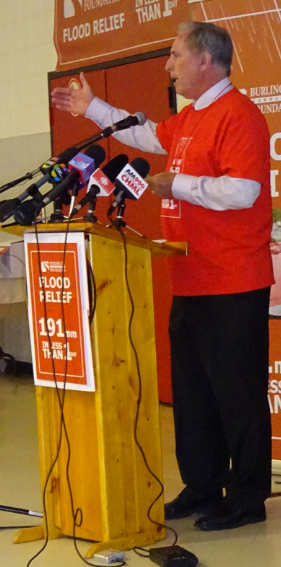 Ron Foxcroft Kicking Off the Flood Relief Campaign. When the fund raising Kick Off event was held in August the Burlington Community Foundation understood that there were potentially 500+ homes that were either under insured or uninsured. They did a quick calculation as to what would be needed and came up with the $2 million figure – and that became the fund raising target.
The BCF didn’t quibble over that number – they just stepped up to the plate and began making phone calls – they also put $15,000 of their own money on the plate. At the time many people were up to their necks in water and sewage – this wasn’t the time to ask a lot of questions.
However, as the amount raised grew the fund raisers began to ask: – just how much money are we going to need? It became increasingly difficult to determine that amount. There was no clear picture on just how many people might need help. Was it 500 homes damaged but covered by insurance or was it 250 homes that were damaged an either didn’t have any insurance or were under insured.
There were many homes, especially in the Regent Road area where homeowners were told they could no longer buy insurance. Others learned that their insurance company had scaled back the level of coverage they could buy.
Burlington believed the provincial government would come through on the two for one Ontario Disaster Relief and Assistance Program (ODRAP). All anyone has heard so far is that we “should be optimistic” which sounds like a politician playing games.
Premier Kathleen Wynne is going to be in Hamilton next Saturday during the Tiger Cats game (who are they going to lose to this time) and will be pinning medals on four members of the Argyll and Sutherland Regiment.
Burlington’s MPP Eleanor McMahon appears to have been left out to dry on this file. Her efforts have been close to heroic but the provincial government doesn’t appear to have all that much – at least so far – for Burlington residents.
 Glenn Nicholson planned on an event to help a senior whose home was badly damaged by the flood: hundreds showed up including the Burlington Teen Tour band The $800,000 raised to date has been due to the outstanding efforts of the Flood Disaster Relief Committee, local businesses, sports organizations, neighbourhood groups and individuals. There was that great street party on Elwood and the $3000+ raised by an 11 year old student Sheil Patel and the $8000 put on the plate by the Lions Club. The supermarkets came through; the banks came through and local merchants put out the donation boxes.
Burlington is close to “donation exhausted” said BCF fund raiser Ron Foxcroft who added “and the flood is no longer front page news. Other organizations – the United Way and the Joseph Brant Hospital need opportunities to raise what they need – the BCF needs to close the books and make the best with what they have raised.”
The Burlington Community Foundation is moving from their fund raising efforts to managing the applications for Losses and Damages claims. The Burlington Community Foundation Flood Disaster Relief Committee is hosting a Town Hall meeting with the Claims Committee and Cunningham Lindsay, the insurance adjuster supporting the initiative. The meeting is planned for Tuesday, November 4th from 7:00 – 9:00 pm to answer questions and provide support to those interested in making a claim.
 Peter Hodgson led the Red Cross data collection drive to find out just how many homes had been flooded and how much help was needed. Councillor Meed Ward wore one of the first flood T-shirts. At this point there have been just 50 applications for financial support. The ODRAP program is intended for those who were either uninsured or under insured.
When the Red Cross did their door-to -door survey work immediately after the flood they reported that there were 500 homes that were severally flooded. However, Peter Hodgson, the Red Cross volunteer who led that data collecting team, found that many people whose homes were flooded said they didn’t want any financial support and that what money there might be should go to people who truly needed financial support.
Hodgson also found that there was no one home at many of the doors they knocked on. “We had no idea if they had suffered severe flood damage and moved out or were just away for a few days.”
Hodgson spent weeks on the data collection work even though his home was flooded and he still doesn’t have the full use of the house he lives in. “it might be three more weeks before all the work is done”, he said.
Colleen Mulholland lives in a house that was badly flooded as does Mayor Goldring and Burlington’s MP Mike Wallace.
 One of the unfortunate elements of this situation is that the information the Red Cross collected and turned over to the Region is being treated as something that comes under the privacy rules which means that the Burlington Community Foundation cannot access that data to communicate with the people who may need financial help and are entitled to financial support. One of the unfortunate elements of this situation is that the information the Red Cross collected and turned over to the Region is being treated as something that comes under the privacy rules which means that the Burlington Community Foundation cannot access that data to communicate with the people who may need financial help and are entitled to financial support.
Colleen Mulholland, president of the Burlington Community Foundation, is spearheading a Town Hall meeting on November 4 at the Seniors Centre on New Street. “We have advertised the event and we hope we get everyone who needs help into the room. “We know there are hundreds of Burlington families who  will qualify for financial assistance and are concentrating our efforts to communicate with those folks and help them through the process,” says Mulholland, President and CEO of the Burlington Community Foundation. “We are also communicating with the provincial government to understand its position on providing financial assistance so we can be crystal clear on how much funding we have to disperse.” will qualify for financial assistance and are concentrating our efforts to communicate with those folks and help them through the process,” says Mulholland, President and CEO of the Burlington Community Foundation. “We are also communicating with the provincial government to understand its position on providing financial assistance so we can be crystal clear on how much funding we have to disperse.”
We believe there are people out there who need the financial support that is available and either don’t have the forms and don’t understand the process.
“There is only so much time left – all the forms have to be submitted by December 14th and this program has to be wrapped up eight weeks after that deadline.”
 The fear is that there will be people who will not apply because they did not know or fully understand and they will lose out. Once the program ends it is over, The fear is that there will be people who will not apply because they did not know or fully understand and they will lose out. Once the program ends it is over,
Since the Application for Losses and Damages became available on September 30th approximately 50 claims have been filed. The Claims Committee has set a deadline of December 14, 2014 for all Applications for Losses and Damages to be submitted. Disbursements will begin over the following eight weeks after the deadline.
 Bank of Montreal dug into their vault and found $20,000 for flood relief. Mulholland explains that “we will have volunteers on hand to work one-on-one to help complete the forms that are required. We will go to people’s homes to help them but we need to know who they are in order to help.
Mulholland would like every person who reads about this situation to tell five people and to ask those five people to tell another five people about the November 4th Town Hall meeting. “We just need to get the word out” she said.
Application forms are available on the BCF website, or they can be mailed out to residents by calling the BCF office at 905-639-0744, ext. 223.

 By Staff By Staff
November 1, 2014
BURLINGTON, ON.
The Ontario Association of Chiefs of Police (OACP) hold an Annual Crime Prevention Week campaign. This year, the Halton Regional Police Service is focusing on the increasing issue of Distracted Driving.
One only has to drive around to see the number of distracted drivers either talking on their cell phones or with their heads down, texting in their laps.
In 2013, distracted driving caused more deaths than impaired driving in Ontario. It is also a direct cause of 30-50 percent of collisions, yet people continue to ignore the warnings and choose to drive distracted putting not only their lives at risk but everyone around them.
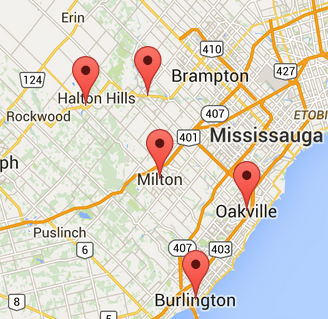 The markers on the map will show how many people in each community actually signed the pledge on line – were you one of them? Halton Regional Police issued a total of 6,857 distracted driving tickets in 2013. From January through to October 2014, 6,916 tickets have been issued. Drivers are not getting the point.
Our “Thumbs Up Against Distracted Driving” campaign is an educational initiative that serves to create awareness and encourage dialogue between drivers of all ages in hopes of getting people to take the pledge to put the phone down.
High School Liaison officers will be engaging youths in high schools around the Region to break the habit and put their phones down while driving. A thumb band with the reminder “W82TXT” will be handed out to be worn.
The Regional police are going close to all out on this educational initiative and have set up a section of their web site where people can “take the pledge” not to text while driving.
They have created a map showing how many people in each community within the Region have taken the pledge.
 “We encourage people to go to our website and take the pledge. A friendly challenge between municipalities can be followed on the map. Take the HRPS Pledge and watch the numbers in your municipality grow” suggest the police. Click here to take that pledge. “We encourage people to go to our website and take the pledge. A friendly challenge between municipalities can be followed on the map. Take the HRPS Pledge and watch the numbers in your municipality grow” suggest the police. Click here to take that pledge.
Let’s all help make Canada’s, more specifically, Halton’s roads the safest in the world!
Follow @HaltonPolice on Twitter and join the conversation using the following hashtags: #HRPSPledge and #W82TXT.

 By Staff By Staff
November 1, 2014
BURLINGTON, ON.
The Halton Region Health Department’s seasonal influenza (flu) immunizations clinics began on October 14, offering vaccine for high-risk individuals only. The clinics will be held at various seniors’ centres throughout the Region. Nurses will be screening residents to ensure they meet the high-risk criteria.
High-risk individuals include:
• those at high risk for complications of the flu; for example, those over 65 or with certain underlying health conditions and pregnant women
• those who may spread the flu to high-risk people; for example health care or other care providers
• those who provide essential community services; for example, paramedics or police officers
High-risk individuals can also receive influenza (flu) immunizations at doctors’ offices and walk-in clinics.
 It doesn`t hurt! The Health Department’s community influenza clinics for all residents aged six months and older are scheduled to begin the week of October 27 in Halton. Flu immunization will also be available at doctor’s offices, walk-in clinics, and, for those aged five years and older, at many pharmacies throughout Halton.
Getting the influenza vaccine every year is the most important way to protect against the flu. It also helps to prevent the spread of the virus to those who are vulnerable to complications of the flu. Influenza immunization is recommended for all those six months of age and older.
Most healthy people recover from the flu within a few days; however, influenza infection can lead to pneumonia, hospitalization, and even death, especially in the elderly, those under five years of age, and those of all ages with certain chronic health conditions.
In addition to getting vaccinated, you can take everyday precautions by washing your hands frequently, using an alcohol-based hand sanitizer if soap and water is not available, and avoiding touching your eyes, nose, and mouth because the influenza virus enters your body through these routes. If you are sick, stay home from work or school to prevent spreading your illness to others, and see your doctor if your illness continues to worsen or does not begin to improve after a few days.
For more information on the flu, including all clinic dates and locations and those considered high-risk, visit the Regional web site – just click here or dial 311.

 By Pepper Parr By Pepper Parr
October 31, 2014
BURLINGTON, ON.
Burlington, through its Public Art Program, has selected artist Simon Frank to install a public art piece at Mountainside Recreation Centre.
Frank was chosen by a community jury through the Public Art Program after the call for proposals produced a list of 32 submissions. The list was shortened to four artists: Karl Ciesluk from Ottawa, Ont., Simon Frank from Hamilton, Ont., Andrew Owen from Toronto, Ont. and Teresa Seaton from Burlington, Ont.
 werc “Frank has a well-established, contemporary art practice that examines the relationship between people and the natural environment,” said the jury’s statement. “He was able to clearly communicate his understanding of the community that the public art will exist in.”
Frank, a poet, artist and rustic furniture-maker, will use community input, the design of Mountainside and the natural area to create his final plan. He will be on site this fall to explore the area and consult with the community as he begins the $25,000 project. Dates, times and locations for public input will be announced.
The public art piece will complement the Mountainside Recreation Centre revitalization project.
Simon Frank was born in 1968 in Glasgow, Scotland, but grew up in Dundas, Ont. Over the past 18 years, Frank has participated in solo and group exhibitions across Ontario, as well as exhibiting in special projects in Saskatoon, Italy and South Korea. He has received grants from both the Canada Council for the Arts and the Ontario Arts Council.
 “Island” at the Dominic Agostino Centre Frank has installed two permanent, public art works in Hamilton: “Island” at the Dominic Agostino Centre (2003) and “Concrete Poetry” on Locke Street (2011). He has also been a finalist in public art competitions in Waterloo and Surrey BC. Frank is a member of the Hamilton-based collective TH&B, which has produced site-specific projects in Hamilton, Kingston, Buffalo and New York.
Over the past eighteen years, Frank has participated in solo and group exhibitions across Ontario, as well as exhibiting in special projects in Saskatoon, Italy and South Korea. He has received grants from both the Canada Council for the Arts and the Ontario Arts Council. Selected exhibitions and offsite projects include: “Take on Me”, Luminato Festival, Toronto (2014); “Romancing the Anthropocene”, Nuit Blanche, Toronto (2013); “View (from the escarpment)”, Art Gallery of Hamilton (2012); “The Tree Project”, McMichael Gallery, Kleinburg (2012); “Terra Incognito”, Rodman Hall, St Catharines (2009); “Earth Art”, Royal Botanical Gardens, Hamilton (2008); “Sketch for New Forest”, The Koffler Gallery,  Toronto (2007); “Wild Wood” Haliburton Forest Preserve, Haliburton (2007); “The Forest for the Trees” Galleria di Arte Contemporanea, La Spezia, Italy (2007); “Ice Follies 2006”, WKP Kennedy Gallery, North Bay (2006); “Gold Leaf” (performance), Art Gallery of Ontario (2005); “Shorelines”, MacLaren Art Centre, Barrie (2005); “Exchange-Changing the Landscape”, The Tree Museum (2004); “SPASM II”, Saskatoon (2004); “The Geumgang Nature Art Project”, Korea (2002); “CAFKA/Power to the People”, Kitchener (2002); “Zone 6B: Art in the Environment”, Hamilton (2000). Frank is also a member of the Hamilton-based collective TH&B, which has produced site-specific projects in Hamilton, Kingston, Toronto, Banff, Buffalo and New York. Toronto (2007); “Wild Wood” Haliburton Forest Preserve, Haliburton (2007); “The Forest for the Trees” Galleria di Arte Contemporanea, La Spezia, Italy (2007); “Ice Follies 2006”, WKP Kennedy Gallery, North Bay (2006); “Gold Leaf” (performance), Art Gallery of Ontario (2005); “Shorelines”, MacLaren Art Centre, Barrie (2005); “Exchange-Changing the Landscape”, The Tree Museum (2004); “SPASM II”, Saskatoon (2004); “The Geumgang Nature Art Project”, Korea (2002); “CAFKA/Power to the People”, Kitchener (2002); “Zone 6B: Art in the Environment”, Hamilton (2000). Frank is also a member of the Hamilton-based collective TH&B, which has produced site-specific projects in Hamilton, Kingston, Toronto, Banff, Buffalo and New York.
The mission of the City of Burlington’s Public Art Program is to enhance the quality of life in Burlington through art. The program strives to bring artwork by both established and emerging artists throughout Burlington.

 By Staff By Staff
October 31, 2014
BURLINGTON, ON
Last Wednesday a male suspect entered the underground parking lot at 421 Maple Avenue, in the City of Burlington. It was 4:30 am
 Early in the morning this man entered two underground garages and smashed the windows of a total of 18 cars to steal the contents. The man targeted parked vehicles and smashed the windows to gain entry. Seven vehicles were damaged and property taken.
The suspect proceeded to another underground parking lot located at 1249 Northshore Blvd in the City of Burlington at approximately 5 am.
Here the male damaged and entered eleven vehicles and made his escape around 5:30 am.
Suspect Description:
Male, white
Approximately 40-50 years of age
Thin build with medium length brown hair
Wearing a black hat, blue “puffy” winter jacket and black cargo pants.
Anyone with information on these incidents are asked to contact Detective Ellie Bale or D/Cst. Lorena Mallinson, 3 District Criminal Investigations Bureau (905) 825-4747 Ext. 2312, ellie.bale@haltonpolice.ca or ext 2334, lorena.mallinson@haltonpolice.ca
Anyone with information on this or any other crime is asked to call Crime Stoppers at 1 800 222-8477 (TIPS) or through the web at www.haltoncrimestoppers.com or by texting “Tip201” with your message to 274637 (crimes).

 By Staff By Staff
October 31, 2014
BURLINGTON, ON.
Janis Ozollapa has been missing since September 30, 2014 at approximately 2 pm.
On Friday October 10, Mr. Ozollapa’s vehicle, a 2002 black
 Janis Ozollapa has been missing since September 30, 2014 Video surveillance of the area revealed an unidentified man running from this area at 5:25 am on Wednesday October 1, 2014. Police have yet to release the video they are working with.
Police are still searching for three possible witnesses that may have seen this unidentified male running westbound on Cross Avenue.
 Chevrolet Avalanche bearing a personalized licence plate “OZOLLAPA” was located in the area of The Lighting Centre on Cross Avenue in the Town of Oakville. Police are reaching out to speak with the drivers of a motorcycle, a pick-up truck and a taxi cab that were driving eastbound at the time and may assist in identifying this unknown male.
Police investigators have no indication of foul play and remain concerned for Mr. Ozollapa as his disappearance is extremely out of character.
Mr. Ozollapa is described as male/white, 6’0”, 170 lbs, medium build, grey eyes, bald, goatee and speaks with a heavy Latvian accent. He was wearing a t-shirt, blue jeans, brown Crocs and had a black laptop briefcase.
One wonders why the police don’t make the video they are working with available.
Anyone with information is asked to contact D/Sergeant Ron Hansen, 3 District Criminal Investigations Bureau at 905 825-4747 ext 2315, or anyone with information on this or any other crime is asked to call Crime Stoppers at 1 800 222-8477 (TIPS) or through the web at www.haltoncrimestoppers.com or by texting “Tip201” with your message to 274637 (crimes).

 By Pepper Parr By Pepper Parr
October 31, 2014
BURLINGTON, ON.
How do you move when the stuff you have weighs a couple of tonnes?
You hold a sale and move what you’ve got to the place where the buyer lives.
 Part of the Rickli Studio Walt Rickli is moving his studio and this weekend will be selling a large part of his inventory which includes many of the items at the Sculpture Garden tucked in behind the Lowville Bistro; 2 Lowville Park Road Burlington
It was close to 20 years that the Nelson Aggregate Quarry let Rickli set up his studio in their quarry. Within the next year the limestone beneath that studio will be transformed into gravel – thus the move. The actual “move out” date is June 1, 2015. “Although it is months away there is a lot of work involved in relocating my world” said Rickli. “It felt like the place to start would be to sell all existing sculptures.
 One of the more evocative stone sculptures in the Rickli collection. The sale takes place today – October 31st, and Saturday, November 1st as well as Sunday November 2nd 2014 at the Studio which is located on the # 2 Sideroad. There are signs at the gate with detailed directions. For those of you using your GPS to get there – the address is: 2433 No 2 Side Rd, Burlington, ON L7P 0G8
All sculptures will be available at 20% to 80% off list pricing.
For more information on what is being offered and the prices attached to pieces – click.
 The event will be held indoors at the studio (where it’s nice and warm!) I will also be including all sculptures on display in my Sculpture Garden in Lowville in this event. The event will be held indoors at the studio (where it’s nice and warm!) I will also be including all sculptures on display in my Sculpture Garden in Lowville in this event.
Also – the winter season is approaching – I will be offering free storage of sold pieces until May 1, 2015 and I will arrange delivery and installation as required.
Rickli will be accepting a limited number of commissioned works over the winter months.

 By Staff By Staff
October 31, 2014
BURLINGTON, ON
The Gazette is a Burlington newspaper published on line and while we are certainly aware of that smokestack called Hamilton to the west of us, we try hard not to be continually angry about all the stuff they spew into the environment.
 They recently did something that we fully approved of and appreciated. They chose Joan Krygsman as a Hamilton Spectator Reader’s Choice Awards winner and named her the First Place Platinum Award winner as BEST LOCAL ARTIST 2014. They recently did something that we fully approved of and appreciated. They chose Joan Krygsman as a Hamilton Spectator Reader’s Choice Awards winner and named her the First Place Platinum Award winner as BEST LOCAL ARTIST 2014.
Joan Krygsman and her Striped Aardvark studio has been doing what has been called colourful, quirky and unique art. They are certainly different – we think delightful – but art is often in the eye of the beholder – so you get to decide.
 Joan is one of those “she’s everywhere” type of people. She plays a guitar and takes part in any group that will invite her. She works with the Rain Barrel people and delegates at Hamilton City Council on almost every issue that touches on the environment. Joan is one of those “she’s everywhere” type of people. She plays a guitar and takes part in any group that will invite her. She works with the Rain Barrel people and delegates at Hamilton City Council on almost every issue that touches on the environment.
Krygsman also does Income Tax returns for people. We came across Joan when we were looking for someone to put together a complex reader survey.
 We learned that Joan was pretty good at revising and upgrading WORDPress themes, which is the software we use to format the Gazette. It was advice from Joan that convinced us to move to the theme we currently have. We learned that Joan was pretty good at revising and upgrading WORDPress themes, which is the software we use to format the Gazette. It was advice from Joan that convinced us to move to the theme we currently have.
Colourful, quirky and unique are words used to describe Joan Krygsman – she is all of the above
For more on Joan slip over to her website . Most of what she produces is for sale.
Krygsman usually takes a small selection of things each weekend to the Wilson Street Farmers Market in Ancaster.

 By Ray Rivers By Ray Rivers
October 31, 2014
BURLINGTON, ON
The term ‘terrorism’ has become almost meaningless today since western leaders apply the label to almost any act of violence, particularly those committed by followers of the Islamic faith. According to dictionary.com, terrorism is “the use of violence and threats to intimidate or coerce, especially for political purposes”. The PM has called the killing of our soldiers by Michael Zehaf-Bibeau and Martin Couture-Rouleau terrorism.
 Michael Zehaf-Bibeau running into the House of Commons with a rifle. But is it really? Sure, these guys were two socially disaffected young men looking to do something noteworthy with their otherwise wasted lives. But no connection has been made between these criminal acts and ISIS, nor of an orchestrated ISIS terror campaign in Canada. It is unlikely that these two deadbeats believed they alone could change Canada’s foreign policy just by killing some soldiers here at home.
There is no question that Canada’s military involvement in Iraq was the spark which ignited the violent actions. But these were desperate acts by ‘lone wolves’ frustrated with the policies of their country and its leadership, and wanting to fight back somehow. Labelling these events as terrorism will not absolve the PM of his responsibility for our safety.
When he enacted the Safe Streets and Communities legislation a few years ago the PM assured us of our security. But now he is going back to the well and dredging up something as scary as permanent martial law, restricting our individual freedom and civil rights. Giving new powers to law enforcement agencies makes little sense when we consider that the perpetrators of these crimes had been in the cross-hairs of the RCMP and CSIS for some time. And wasn’t this the PM who abolished the long gun registry, thus enabling the uncontrolled proliferation and use of illegal firearms, like the one that killed Cpl. Nathan Cirillo?
Before he draws up new laws the PM should first consider his rush into the undeclared war on ISIS. Going to war is always a serious matter. For starters, there needs to be a defensible rationale for going to war. But Canada was neither attacked nor seriously threatened by ISIS (or ISIL). Offensive military action in the absence of these conditions is in contravention of the UN charter and thus illegal. So under what authority are we putting Canadians into harms’ way?
Of course ISIS is a nasty organization and its goal of establishing statehood is a concern. But there are so many other disagreeable people out there. And Canada has no ‘dog’ in this fight, unlike the US which had been an occupying power. We haven’t even suffered reporters beheaded by ISIS. And finally, the US has more than enough military equipment already there to bomb the dwindling number of ISIS targets onto oblivion. They don’t really need us.
 Canadian CF 18 aircraft now in the Middle East Still, our Gunslinging PM decided we need to hop into this fight. Without a game plan, without a plausible rationale for involvement, and without even a modest consultation with Canadians, he rushed into war. Ground forces were on their way to Iraq before the PM even made it home from the NATO meeting where this issue was a side-topic. Then, using his majority in Parliament, he rammed through a dispatch of fighter jets, against a united opposition here at home.
When a a nation goes to war it needs to secure its home-front as well as the war-front. War requires additional resources be expended, including funding to beef up national security and prevent the very kind of incidents we have just witnessed. It is clear, sadly, that the PM never anticipated any domestic blow back from his actions, nor provisioned for enhanced domestic security. As I noted in an earlier article, he probably just saw this escapade as target practice for our fly boys, in a warmer climate with real people as targets.
 The official opposition party had voted against sending the fighter jets without a more detailed discussion and a game plan. The third party had argued that Canada would have been more useful providing enhanced humanitarian aid. The PM would have done well to have followed their advice. The official opposition party had voted against sending the fighter jets without a more detailed discussion and a game plan. The third party had argued that Canada would have been more useful providing enhanced humanitarian aid. The PM would have done well to have followed their advice.
November the 11th is Remembrance Day, and this year there will be another two soldiers to remember, and we will. But we should also not forget that this might have been avoided had we been just a little less eager to send our troops off to war – or at least done our homework before undertaking the mission. Isn’t that what Remembrance Day is supposed to be all about?
 Ray Rivers writes weekly on both federal and provincial politics, applying his more than 25 years as a federal bureaucrat to his thinking. Rivers was a candidate for provincial office in Burlington where he ran against Cam Jackson in 1995, the year Mike Harris and the Common Sense Revolution swept the province. Ray Rivers writes weekly on both federal and provincial politics, applying his more than 25 years as a federal bureaucrat to his thinking. Rivers was a candidate for provincial office in Burlington where he ran against Cam Jackson in 1995, the year Mike Harris and the Common Sense Revolution swept the province.
Background links:
Not Terrorism Terrorism or Mental illness More Spying More Security
Unknown Gun Canada’s Role in the World Middle East Interventions
ISIS in Canada
Lone Gunman More Restrictive Laws Video
More Police Powers

 By Staff By Staff
October 29, 2014
BURLINGTON, ON
A man police believe was responsible for a sexual assault that occurred two months ago in the City of Burlington has been arrested
On Friday, August 29, 2014, a 16-year-old female was working alone at the Bronze Beach Tanning Salon on Brant Street. The accused was in the salon and engaged the female in conversation. The accused convinced the female to go into a tanning room where he inappropriately touched her.
On Tuesday, October 28, 2014, the accused was arrested by members of the Child Abuse and Sexual Assault Unit.
Accused:
Colin TYLEMAN, 45 years, from the City of Hamilton has been charged with Sexual Assault, due in court on November 26, 2014 at 9 am.
Anyone with information regarding this investigation is asked to contact D/Cst Wendy Clayton of the Child Abuse and Sexual Assault Bureau at 905 825-4747 ext 8980 or anyone with information on this or any other crime is also encouraged to call Crime Stoppers at 1 800 222-8477 (TIPS) or through the web at www.haltoncrimestoppers.com or by texting “Tip201” with your message to 274637 (crimes).

 By Pepper Parr By Pepper Parr
October 30, 2014
BURLINGTON, ON
They have been doing it for more than ten years.
 Artists who put on an arts tour during a weekend that give Burlingtonians a chance to visit nine studios where there are three, sometimes four different artists displaying their work. Artists who put on an arts tour during a weekend that give Burlingtonians a chance to visit nine studios where there are three, sometimes four different artists displaying their work.
Art in Action has been doing this for more than ten years. Each year new artists are added and others who have been showing for a while are dropped off. The studios are scattered about the city with well-marked directions.
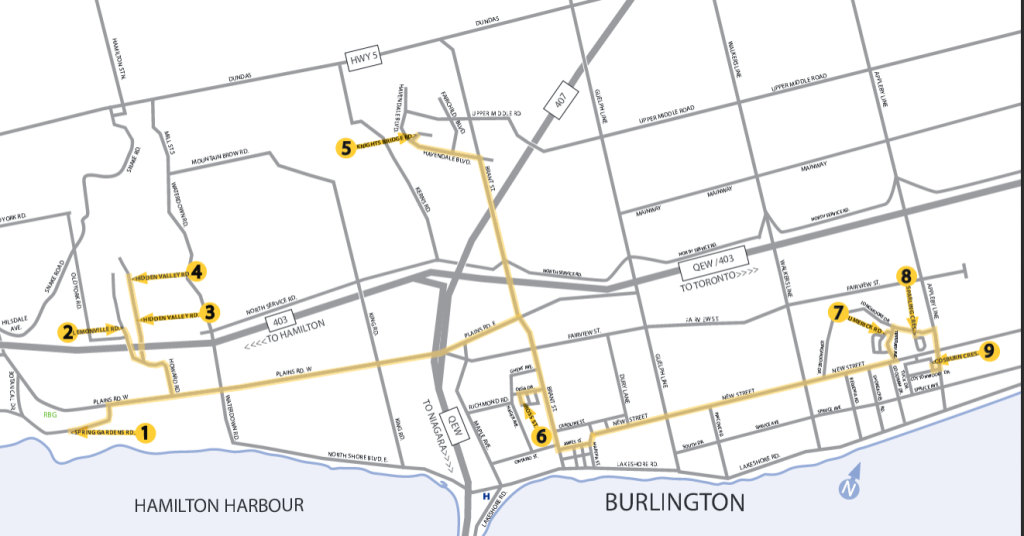 The selection this year in the nine studios include: The selection this year in the nine studios include:
 STUDIO 1 STUDIO 1
654 SPRING GARDEN RD
Teresa Seaton – Stained Glass Artist
Helen Griffiths – Fine Artist
Josh Tiessen – Fine Artist
Silvana Terry – Jewellery Artist
STUDIO 2
1247 LEMONVILLE RD
George Wilkinson – Wood Turner
Kim DiFrancesco- Fine Artist
Done Graves-Fine Artist
Monica Bell – Quilter
 STUDIO 3 STUDIO 3
1292 HIDDEN VALLEY RD
Ed Hoyer – Fine Artist
Maria Hoyer- Fine Artist
Kathy Fenton – Jewellery Artist
Casandra Ward – Fine Artist
STUDIO 4
1359 HIDDEN VALLEY RD
Julio Ferrer – Fine Artist
Tamara Kwapich – Fine Artist
Liz Meister – Jewellery Artist
STUDIO 5
1295 Knights Bridge Court
Ian Cowling – Photographer
Aubrey Denomy – Sculptor
Brian Harris – Fine Artist
Karen Harris – Clay Sculptor
 STUDIO 6 STUDIO 6
711 ROSS ST
Dan Jones – Photographer
Glen Jones – Photographer
Fred Oliver – Photographer
STUDIO 7
531 Limerick Road
Anne More – Fine Artist
Donna Fratesi – Fine Artist
Joe Speck – Glass Fuser
Marilyn Walsh – Sculptor
STUDIO 8
424 SPARLING CRES.
Donna Grandin – Fine Artist
Lois Shaw- Fine Artist
Louise Young – Jeweller
 STUDIO 9 STUDIO 9
377 Cosburn Crescent
Dave Lawson – Photographer
John Highley – Glass Mosaic Artist
Peter Schlotthauer – Artist Blacksmith
Tammy Warren – Jewellery Artist
For those who make the tour an annual event – there is the opportunity to watch an artist grow and evolve. And you tend to meet people at a one studio that you met at a different studio earlier in the day and you exchange views on what you saw and what you liked and didn’t like.
You find yourself returning to favourite artists and wondering if you can afford what they have knowing that you would like to have that painting or piece of quilt work in your home.
 Don Graves, on the right, showing a canvas to a perspective buyer (she bought) will head up the Art Discussions program for the Art in Action crowd. During one of the previous tours it was a delight to watch Don Graves selling a small piece of work to a young woman who was a first time art buyer. Nice too to see Graves mount a show at the Art Gallery of Burlington that saw a slightly different direction in his work.
It was with some delight that we got a request from a Gazette reader asking if we could put them in touch with Don Graves – they had seen one of his paintings and wanted to talk to hm about a possible purchase. We put the two people together but never learned if a sale took place.
 Darlene Throop, on the right, presents Bateman High School students Sarah Tom with the 2014 Art in Action $1500. scholarship. Each year the Art in Action group awards a scholarship to a Halton student. The award for this year went to Sarah Tom.

 By Staff By Staff
October 29, 201`4
BURLINGTON, ON.
The woman found deceased in that Pearl Street apartment on Monday was Elizabeth Nugent, 32 years of age; she resided in the apartment building.
 Nugent was found deceased after a barricaded suspect incident in the City of Burlington on Monday October 27th, 2014. Nugent was found deceased after a barricaded suspect incident in the City of Burlington on Monday October 27th, 2014.
The victim and the accused were involved in an intimate relationship.
The cause of death has not been confirmed at this time.
The accused, Malcolm Copeland, 41 years from the City of Markham has been charged with Second Degree Murder and will return to Milton court on October 30th, 2014.
 The police were called to the scene at around 10 am when loud voices were heard. When they arrived they found a suspect barricaded in the apartment. Negotiations took place but proved fruitless and police battered the door and entered the apartment in the afternoon. The police were called to the scene at around 10 am when loud voices were heard. When they arrived they found a suspect barricaded in the apartment. Negotiations took place but proved fruitless and police battered the door and entered the apartment in the afternoon.
The circumstances surrounding this incident are still under investigation by Homicide investigators, anyone with information is asked to contact Det. Blair Moroso, Homicide Unit or Crime Stoppers at 1 800 222-8477 (TIPS) or through the web at www.haltoncrimestoppers.com or by texting “Tip201” with your message to 274637 (crimes).

 By Walter Byj By Walter Byj
October 28, 2014
BURLINGTON, ON.
I did make a mistake by saying that 80% did not vote for Blair. It should have read 70%.
29% did vote for Blair.
Walter
So who is the winner in an election that has 10 candidates? By our current rules, the candidate who gets the most votes wins. No argument. In ward 6, Blair Lancaster got the most votes, 2087 which was 445 more than the next candidate, Angelo Bentivegna. So clearly, she was the candidate that won.
 But what about the electorate, did they win? The 2,087 votes that Lancaster received represented 29.8% of all votes cast. This meant that 70% of those who voted did not want Blair Lancaster to represent them at council. In fact taking it a step further of the 22,579 voters eligible in ward 6, only 9.2% voted for Blair. Now perhaps it is unfair to include non voters in this review, but wasn’t ward 6 ripe for change? Or did the pundits get it wrong? But what about the electorate, did they win? The 2,087 votes that Lancaster received represented 29.8% of all votes cast. This meant that 70% of those who voted did not want Blair Lancaster to represent them at council. In fact taking it a step further of the 22,579 voters eligible in ward 6, only 9.2% voted for Blair. Now perhaps it is unfair to include non voters in this review, but wasn’t ward 6 ripe for change? Or did the pundits get it wrong?
With a turnout of 30.9%, many in the ward appear to be pleased with their current Councillor and decided not to vote. But that does not discount the fact that of those who voted, 70% wanted change.
So how can Councillor Lancaster make the electorate winners also?
Well how about a town hall meeting where the electorate can voice their opinions. Lancaster is guaranteed the job for the next 4 years so why not reach out to the community and learn how to serve them better. Lancaster doesn’t have to take this route, but it would be the kind of good gesture that would allow those who did not vote for her feel they are still being represented
Perhaps specific committees could be formed within the riding that could assist in developing solutions to some of the problems? Ward 6 is a large geographical area with issues unique to select different parts of the ward.
Or will Lancaster feel that the election is won and will continue to be the Councillor that she has been for the past four years? Time will tell.
 Walter Byj has lived in Burlington for more than 25 years. He lives in ward 6 Walter Byj has lived in Burlington for more than 25 years. He lives in ward 6

 By Lana Kamarić By Lana Kamarić
October 28, 2014
BURLINGTON, ON.
Thursday evening, at the Edy Roy Glass Gallery on Spring Garden Road, just in behind the Royal Botanical Gardens, True Visage, a specialty show for Devil’s Night will take place.
True Visage will be featuring a new body of work from Salt, a glass artist from Austin Texas, which will include his glass pipe work as well as a series of masks – appropriate for the occasion.
In these new pieces, Salt examines the masks we wear through the faces we put on for the world. He plays with the concept in both a literal and figurative sense, postulating that while we do not necessarily cover our faces with a latex shield we do tend to smile even when we are not happy.
 Latex masks with removable glass eyeballs are part of the True Visage exhibit at the Edy Roy Faller this Thursday Salt has collaborated with special effects artist Kim Zii to create latex masks with removable glass eyeballs. Zii is also an experienced glass and make-up artist from Philadelphia.
In addition to the masks Salt will also be displaying a series of glass pipes. As a functional piece he raises the question of whether the pipe is disguised as art or if the art is disguised as a pipe. Salt describes the pipe as a product of its environment – much like the faces we wear for the world.
Salt’s work often resembles monsters and strange creatures. True Visage was created specifically for this Halloween geared show. Edy Roy Glass Gallery strives to promote original and unique pieces. Creative director, Kyle Brooke, focuses on pieces from “artists that have something to say and have a voice.”
While the gallery does display traditional soft glass work, they also work to showcase the contemporary glass movement that involves borosilicate glass work, which tends to be more functional. Brooke provided some insight into this movement, specifically that of glass pipe art. She describes this art form as a subculture much like graffiti and tattoo art.
 Kim Zit’s glass pipes are a subculture much like graffiti and tattoo art Brooke also mentioned how this art form has become its own industry and gathered many followers. Artists do events all over the world and are often regarded as “rockstars” in their field. Brooke discovered this movement in the US and is working to bring more of it to Canadian audiences.
The opening night will be this Thursday October 30th. A private showing will take place for the sponsors on the opening night, however the show will be open to the public from 6 – 10pm.
The Edy Roy Glass Gallery exhibits are very popular and draw a lot of people for their specialty shows. Line ups are not uncommon – it is expected to be quite the event. In the spirit of Halloween the event will be a masquerade, so bring your mask.
 Lana Kamarić is a contemporary surrealist artist and a self-taught painter. Born in Sarajevo, Bosnia Lana arrived in Canada at the age of five. After moving to Burlington she attended Robert Bateman High school and graduated from York University with a degree in Art History. Lana has worked with the Museums of Burlington, the Art Gallery of Burlington and is currently working as a full-time artist. Lana was a participant in Cirque, the 2014 No Vacancy installation event in the Village Square. Her last show was Art in the Workplace at McMaster Innovation Park. Lana Kamarić is a contemporary surrealist artist and a self-taught painter. Born in Sarajevo, Bosnia Lana arrived in Canada at the age of five. After moving to Burlington she attended Robert Bateman High school and graduated from York University with a degree in Art History. Lana has worked with the Museums of Burlington, the Art Gallery of Burlington and is currently working as a full-time artist. Lana was a participant in Cirque, the 2014 No Vacancy installation event in the Village Square. Her last show was Art in the Workplace at McMaster Innovation Park.

 By Staff By Staff
October 28, 2014
BURLINGTON, ON.
The Halton Regional Police have charged Malcolm Copeland, the suspect in the barricaded incident on Pearl Street in Burlington, with Second Degree Murder.
The accused is scheduled for his first appearance in Milton court today, Tuesday October 28th.
Investigators are continuing efforts to confirm the victim’s identity.
Police responded to a noise complaint Monday at around 10:00 am and found an armed person barricaded in an apartment.
After several hours of negotiations police broke into the apartment and arrested a male person and then found the body of a female who was pronounced dead at the scene.
The police investigation kept people on Pearl Street out of the homes and places of business until early in the afternoon.
Link to previous news story.

 By Pepper Parr By Pepper Parr
October 28, 2014
BURLINGTON, ON
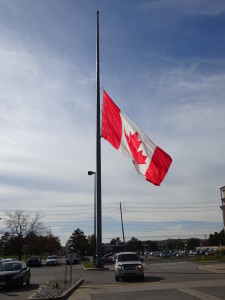 At just a little after 8:30 this morning, a military driver parked outside Ron Foxcroft’ s home in Burlington to take Ron and his wife Marie to the funeral for Corporal Nathan Cirillo in Hamilton. At just a little after 8:30 this morning, a military driver parked outside Ron Foxcroft’ s home in Burlington to take Ron and his wife Marie to the funeral for Corporal Nathan Cirillo in Hamilton.
Foxcroft is the Honorary Colonel of the The Argyll and Sutherland Highlanders of Canada. It is an honorary appointment and for the most part a ceremonial role which Foxcroft does very well. He is a folksy, easy going man with that touch for the everyday and at times mundane things that he manages to make interesting and important.
Foxcroft, a basketball referee by passion and a successful entrepreneur by profession, has made an international business out of a piece of plastic that is used as a whistle in every major sport in the world. All this by a guy who didn’t graduate from high school – he was politely asked to leave.
When news of the shooting and death of Corporal Cirillo got to Foxcroft he knew exactly what he had to do – what he didn’t know was how much it was going to take out of him.
Foxcroft is head of the fundraising side of the Burlington Community Foundation Flood Disaster Relief fund. He had to put that on hold and spend the next five days at the Argyll armoury in Hamilton.
“This wasn’t what I signed up for” said Foxcroft as he readied himself for the funeral this morning. “We had dinner last night with the immediate family and the five first responders” said Foxcroft. Corporal Cirillo’s mother wanted to know how her son died.
Barbara Winter’s, a lawyer with 17 years’ experience in the Naval reserve, was walking past the War Memorial in Ottawa on her way to a meeting when she heard the shot and knew immediately that something was wrong. In less than a minute she was on the ground beside the fallen soldier. She was one of five people attending to Cirillo while they waited for an ambulance.
They began trying to find a pulse, one feeling his neck, one his wrist. Remarkably, everyone on the scene had First Aid or medical training. Instinctively, they began operating as a team, talking and encouraging one another.
They began CPR. The soldier at Cirillo’s head started mouth-to-mouth respiration. Winters began compressing Cirillo’s chest. After a time, someone else relieved her on the chest compressions, and Winters moved to Cirillo’s head. She talked to him, comforting him.
“You are loved. Your family loves you. You’re a good man,” she told him.
“Corporal Cirillo’s Mother needed to hear all the details and asked questions of the five responders who were in Hamilton for the funeral and attended the dinner”, said Foxcroft. “I needed to keep it together but it was not easy.”
“It was an exhaustive period of time and part of the job the Honorary Colonel does” explained Foxcroft. While I have rank, I don’t have authority and the men and women of the Regiment are able to talk to me openly.” Last week they needed someone to talk to and Foxcroft was there.
The Regimental Padre knew it was time to let people leave the dinner and prepare for the funeral.
“This task, this experience was not anything I was trained for – but I knew those troops needed me and I was there for them each day”, said Foxcroft.
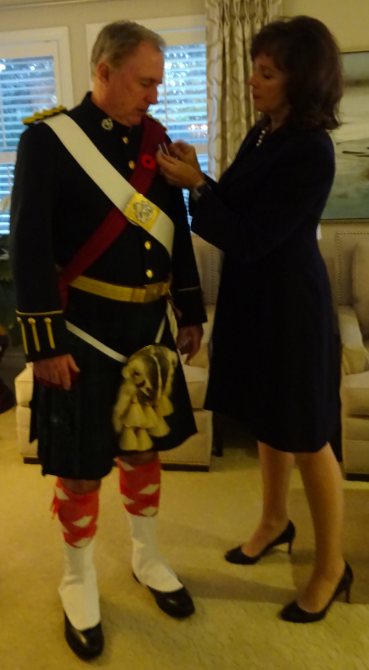 Marie Foxcroft adjusts the medals on her husband’s uniform as they prepare for the funeral of Corporal Nathan Cirillo. Wednesday Foxcroft leaves to referee a Raptors game and on the weekend he will be speaking to a group of ‘first responders’ taking part in a course in Niagara Falls.
The Queen is the Colonel in Chief for the Argyll’s. As the Honorary Colonel Foxcroft wrote the Queen advising her of the death of a Corporal in her Regiment.
Your Majesty:
The events of a troubled world are rarely coloured in Canadian hues. Yesterday’s savage act in Ottawa was an exception.
“The eyes of the world focused on the violent death of a young unarmed Canadian soldier as he mounted silent and respectful at the Tomb of the Unknown Soldier. What is less well known is that Corporal Nathan Cirillo was a serving member of Your Majesty’s Canadian Argylls. It is my sad duty to bring notice of this salient fact to his Colonel in Chief.
At this time of Regimental loss, Argylls remember their Colonel in Chief and reaffirm our dedication to service and the principles they embody.
I remain Your Majesty’s humble and obedient servant,
Ron Foxcroft
Honorary Colonel
Queen Elizabeth responded:
Colonel Foxcroft
“I was so very sorry to learn of the death of Corporal Nathan Cirillo under such grievous circumstances. I send my deepest sympathy to all those affected by this tragedy, in particular to members of Corporal Cirillo’s own family
Elizabeth R
It wasn’t what Ron Foxcroft signed up for – but it is what he was able to do for his troops.

 By Pepper Parr By Pepper Parr
October 27, 2014
BURLINGTON, ON.
Burlington seemed to be a little more animated leading up to the 2014 municipal election.
There was one absolutely fascinating ward where nine candidates were running against a first term incumbent. My colleague Joan Little, who writes a column for the Spectator and shares the media table at Burlington city council, tells me that she cannot recall when there have been that many candidates running against an incumbent.

Little has served as a Burlington Council member and a member of the Regional council. She was first elected in 1973 – so Joanie knows what she is talking about. Blair Lancaster has set a new election record for the city; she defeated all nine handily and knocked out a strong advocate who lead the north Burlington community against the air park which while it didn’t show up on the radar screen is nevertheless a significant issue for the city.
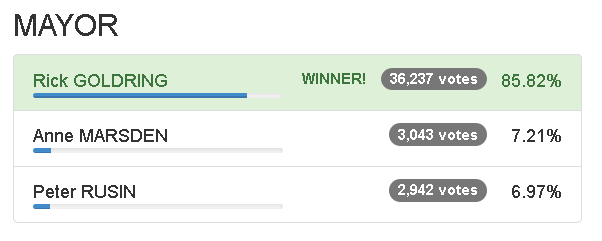 Mayor Goldring took 85% + of the vote. Peter Rusin, who came in late in the game to insure that there was a debate on the issues and the Mayor’s leadership garnered fewer votes than Anne Marsden who claims she was on her way to city hall to register as a candidate the same day Rusin registered. Mayor Goldring took 85% + of the vote. Peter Rusin, who came in late in the game to insure that there was a debate on the issues and the Mayor’s leadership garnered fewer votes than Anne Marsden who claims she was on her way to city hall to register as a candidate the same day Rusin registered.
Burlington is happy with the man who wears the chain of office and he will serve for the next four years.
He will also have exactly the same Council that he had Monday morning. Except for Lancaster none of the incumbents was seriously threatened. Councillors Craven, Meed Ward and Taylor were shoo ins from the beginning.
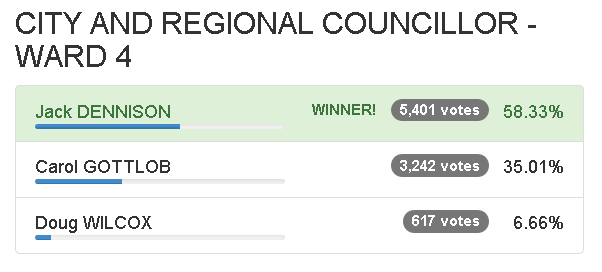
Some, including the Gazette, thought Jack Dennison was in trouble. The voters south of New Street were not happy with Dennison over his application for a lot severance on his Lakeshore Road home. The city’s Committee of Adjustment denied the application; Dennison appealed to the Ontario Municipal Board. That OMB hearing has been postponed twice.
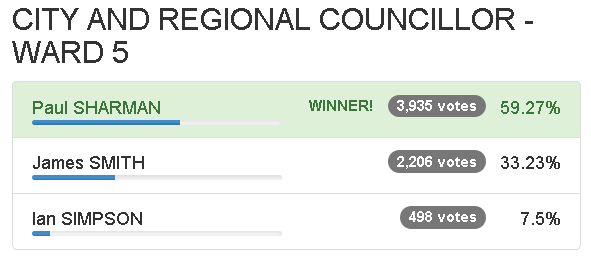
Paul Sharman in ward 5 was felt to be up against a strong contender. The vote count from 2010 suggested James Smith had enough going for him to take the seat this year. Sharman prevailed.
During the campaign Mayor Goldring said he saw his first term as a “cleanup/set-up” period of time.
Other than cleaning up the problems with the pier – there wasn’t much more to get done.
References to the Cam Jackson damage are overblown. Jackson had a different way of doing things that senior people at city hall didn’t like and the public didn’t want to see continue – so they turfed him and went for Goldring.
Rick Goldring passed the smell test last night. Peter Rusin thought he was a weak leader; so did a number of others but the people who pay their tax bills every year didn’t think so and they have asked Rick Goldring to continue being Mayor. One can’t argue with 85%
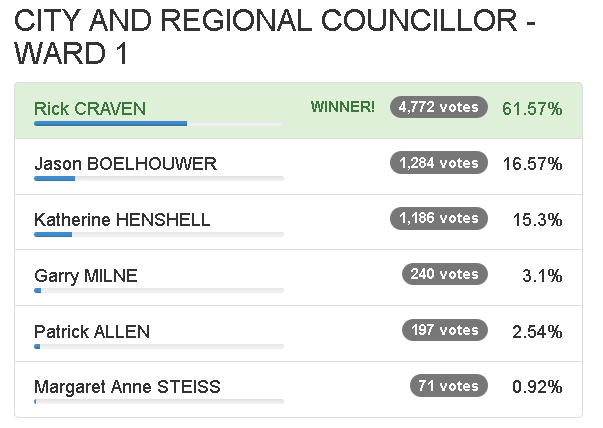 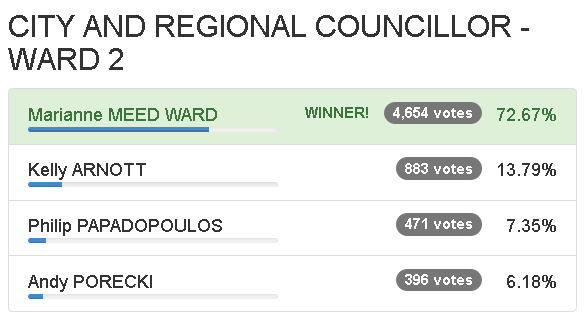 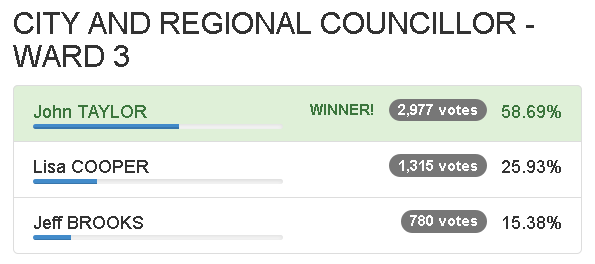 Councillors, Craven, Taylor and Meed Ward each took their wards with solid majorities. Councillors, Craven, Taylor and Meed Ward each took their wards with solid majorities.
One can argue with 34.14% which was the number of eligible voters who went to the polls. The city made it easy to vote. The advance polls were convenient and voting electronically was certainly seen as very convenient by a lot of people.
Toronto got more than 64% of its voters out; does Burlington need a Rob Ford type of disaster to get voters out of their LazyBoy chairs and take a stroll to the polling station?
There are a number of matters on the 2014-2018 order paper that just might rile voters enough to get them out to vote.
But that is for another day.
Today, congratulations to the members of Council; several had tough campaign’s to run. Our Mayor had his feet held to the flames and those who voted said they were content with what they have.

 By Pepper Parr By Pepper Parr
October 27-14
BURLINGTON, ON.
With less than 10% of the polls reporting this is what the picture looked like in those races that were thought to be contentious.
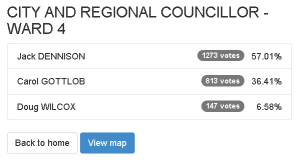
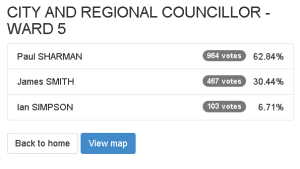
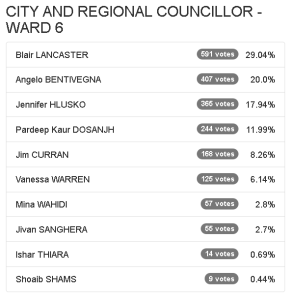


By Pepper Parr
October 27, 2014
BURLINGTON, ON.
Early, early, early results show all the members of city council being returned.
Dennison was leading Gottlob by more than 30%; Lancaster was leading Bentivegna by more than 100 votes; Mayor Goldring was ahead of Rusin by more than a country mile – with Anne Marsden doing better than Rusin.
The Southeast Asian community was pretty close to a no show situation and Vanessa Warren was doing very poorly.
Marianne Meed Ward was walking all over Kelly Arnott.
We may be eating some crow later this evening

 By Staff By Staff
October 27, 2014
BURLINGTON, ON.
At around 10 am this morning police were called to 478 Pearl Street responding to a verbal altercation in one of the apartments.
Police found a person barricaded in an apartment. He told police he was armed.
Police started negotiations with the barricaded suspect and at approximately 2 pm, Tactical Rescue Unit officers forced entry into the apartment and arrested the accused.
While searching the apartment, the body of a deceased female was located. The investigation is continuing in efforts to confirm the victim’s identity.
Accused:
Malcom Copeland, 41, from City of Markham
Officers are continuing to investigate this incident and charges are yet to be determined.
A resident reported the following:
“When I attempted to return home at 11:15 a.m. I was met with police vehicles blocking off entrance to my street and I could see police officers with guns drawn peaking around Elizabeth Manor Apartments looking up at the Wellington Place apartments on Pearl Street.
“The officer posted at the end of my street indicated that they were searching for a gunman and it was prudent to leave the area. What?! It was hard to believe this was happening in ‘my’ lovely downtown Burlington. Our little City is starting to experience serious and very scary big City issues.
“It is 4:30 p.m. and we’ve been allowed to return home. However, the police presence is still significant, there is a SWAT Van in the Lions Club parking lot and many cruisers scattered along the downtown streets.
“There are detectives taking photographs and detectives measuring various areas around the building. It is hard to believe this is downtown Burlington. I only hope no one was seriously injured in whatever horrible situation transpired.”
Our resident was unaware that the body of a female was found deceased in the apartment.
Anyone who has any information are asked to contact the Halton Regional Police Homicide Unit at 905 825-4747 ext 8769, or, anyone with information on this or any other crime is asked to call Crime Stoppers at 1 800 222-8477 (TIPS) or through the web at www.haltoncrimestoppers.com or by texting “Tip201” with your message to 274637 (crimes).

|
|
 By Pepper Parr
By Pepper Parr



 One of the unfortunate elements of this situation is that the information the Red Cross collected and turned over to the Region is being treated as something that comes under the privacy rules which means that the Burlington Community Foundation cannot access that data to communicate with the people who may need financial help and are entitled to financial support.
One of the unfortunate elements of this situation is that the information the Red Cross collected and turned over to the Region is being treated as something that comes under the privacy rules which means that the Burlington Community Foundation cannot access that data to communicate with the people who may need financial help and are entitled to financial support. will qualify for financial assistance and are concentrating our efforts to communicate with those folks and help them through the process,” says Mulholland, President and CEO of the Burlington Community Foundation. “We are also communicating with the provincial government to understand its position on providing financial assistance so we can be crystal clear on how much funding we have to disperse.”
will qualify for financial assistance and are concentrating our efforts to communicate with those folks and help them through the process,” says Mulholland, President and CEO of the Burlington Community Foundation. “We are also communicating with the provincial government to understand its position on providing financial assistance so we can be crystal clear on how much funding we have to disperse.” The fear is that there will be people who will not apply because they did not know or fully understand and they will lose out. Once the program ends it is over,
The fear is that there will be people who will not apply because they did not know or fully understand and they will lose out. Once the program ends it is over,














 “We encourage people to go to our website and take the pledge. A friendly challenge between municipalities can be followed on the map. Take the HRPS Pledge and watch the numbers in your municipality grow” suggest the police.
“We encourage people to go to our website and take the pledge. A friendly challenge between municipalities can be followed on the map. Take the HRPS Pledge and watch the numbers in your municipality grow” suggest the police. 



 Toronto (2007); “Wild Wood” Haliburton Forest Preserve, Haliburton (2007); “The Forest for the Trees” Galleria di Arte Contemporanea, La Spezia, Italy (2007); “Ice Follies 2006”, WKP Kennedy Gallery, North Bay (2006); “Gold Leaf” (performance), Art Gallery of Ontario (2005); “Shorelines”, MacLaren Art Centre, Barrie (2005); “Exchange-Changing the Landscape”, The Tree Museum (2004); “SPASM II”, Saskatoon (2004); “The Geumgang Nature Art Project”, Korea (2002); “CAFKA/Power to the People”, Kitchener (2002); “Zone 6B: Art in the Environment”, Hamilton (2000). Frank is also a member of the Hamilton-based collective TH&B, which has produced site-specific projects in Hamilton, Kingston, Toronto, Banff, Buffalo and New York.
Toronto (2007); “Wild Wood” Haliburton Forest Preserve, Haliburton (2007); “The Forest for the Trees” Galleria di Arte Contemporanea, La Spezia, Italy (2007); “Ice Follies 2006”, WKP Kennedy Gallery, North Bay (2006); “Gold Leaf” (performance), Art Gallery of Ontario (2005); “Shorelines”, MacLaren Art Centre, Barrie (2005); “Exchange-Changing the Landscape”, The Tree Museum (2004); “SPASM II”, Saskatoon (2004); “The Geumgang Nature Art Project”, Korea (2002); “CAFKA/Power to the People”, Kitchener (2002); “Zone 6B: Art in the Environment”, Hamilton (2000). Frank is also a member of the Hamilton-based collective TH&B, which has produced site-specific projects in Hamilton, Kingston, Toronto, Banff, Buffalo and New York.







 The event will be held indoors at the studio (where it’s nice and warm!) I will also be including all sculptures on display in my Sculpture Garden in Lowville in this event.
The event will be held indoors at the studio (where it’s nice and warm!) I will also be including all sculptures on display in my Sculpture Garden in Lowville in this event. 
 They recently did something that we fully approved of and appreciated. They chose Joan Krygsman as a Hamilton Spectator Reader’s Choice Awards winner and named her the First Place Platinum Award winner as BEST LOCAL ARTIST 2014.
They recently did something that we fully approved of and appreciated. They chose Joan Krygsman as a Hamilton Spectator Reader’s Choice Awards winner and named her the First Place Platinum Award winner as BEST LOCAL ARTIST 2014. Joan is one of those “she’s everywhere” type of people. She plays a guitar and takes part in any group that will invite her. She works with the Rain Barrel people and delegates at Hamilton City Council on almost every issue that touches on the environment.
Joan is one of those “she’s everywhere” type of people. She plays a guitar and takes part in any group that will invite her. She works with the Rain Barrel people and delegates at Hamilton City Council on almost every issue that touches on the environment. We learned that Joan was pretty good at revising and upgrading WORDPress themes, which is the software we use to format the Gazette. It was advice from Joan that convinced us to move to the theme we currently have.
We learned that Joan was pretty good at revising and upgrading WORDPress themes, which is the software we use to format the Gazette. It was advice from Joan that convinced us to move to the theme we currently have.


 The official opposition party had voted against sending the fighter jets without a more detailed discussion and a game plan. The third party had argued that Canada would have been more useful providing enhanced humanitarian aid. The PM would have done well to have followed their advice.
The official opposition party had voted against sending the fighter jets without a more detailed discussion and a game plan. The third party had argued that Canada would have been more useful providing enhanced humanitarian aid. The PM would have done well to have followed their advice.
 Artists who put on an arts tour during a weekend that give Burlingtonians a chance to visit nine studios where there are three, sometimes four different artists displaying their work.
Artists who put on an arts tour during a weekend that give Burlingtonians a chance to visit nine studios where there are three, sometimes four different artists displaying their work.
 STUDIO 1
STUDIO 1 STUDIO 3
STUDIO 3 STUDIO 6
STUDIO 6 STUDIO 9
STUDIO 9

 Nugent was found deceased after a barricaded suspect incident in the City of Burlington on Monday October 27th, 2014.
Nugent was found deceased after a barricaded suspect incident in the City of Burlington on Monday October 27th, 2014. The police were called to the scene at around 10 am when loud voices were heard. When they arrived they found a suspect barricaded in the apartment. Negotiations took place but proved fruitless and police battered the door and entered the apartment in the afternoon.
The police were called to the scene at around 10 am when loud voices were heard. When they arrived they found a suspect barricaded in the apartment. Negotiations took place but proved fruitless and police battered the door and entered the apartment in the afternoon.
 But what about the electorate, did they win? The 2,087 votes that Lancaster received represented 29.8% of all votes cast. This meant that 70% of those who voted did not want Blair Lancaster to represent them at council. In fact taking it a step further of the 22,579 voters eligible in ward 6, only 9.2% voted for Blair. Now perhaps it is unfair to include non voters in this review, but wasn’t ward 6 ripe for change? Or did the pundits get it wrong?
But what about the electorate, did they win? The 2,087 votes that Lancaster received represented 29.8% of all votes cast. This meant that 70% of those who voted did not want Blair Lancaster to represent them at council. In fact taking it a step further of the 22,579 voters eligible in ward 6, only 9.2% voted for Blair. Now perhaps it is unfair to include non voters in this review, but wasn’t ward 6 ripe for change? Or did the pundits get it wrong? 




 At just a little after 8:30 this morning, a military driver parked outside Ron Foxcroft’ s home in Burlington to take Ron and his wife Marie to the funeral for Corporal Nathan Cirillo in Hamilton.
At just a little after 8:30 this morning, a military driver parked outside Ron Foxcroft’ s home in Burlington to take Ron and his wife Marie to the funeral for Corporal Nathan Cirillo in Hamilton.

 Mayor Goldring took 85% + of the vote. Peter Rusin, who came in late in the game to insure that there was a debate on the issues and the Mayor’s leadership garnered fewer votes than Anne Marsden who claims she was on her way to city hall to register as a candidate the same day Rusin registered.
Mayor Goldring took 85% + of the vote. Peter Rusin, who came in late in the game to insure that there was a debate on the issues and the Mayor’s leadership garnered fewer votes than Anne Marsden who claims she was on her way to city hall to register as a candidate the same day Rusin registered.



 Councillors, Craven, Taylor and Meed Ward each took their wards with solid majorities.
Councillors, Craven, Taylor and Meed Ward each took their wards with solid majorities.





